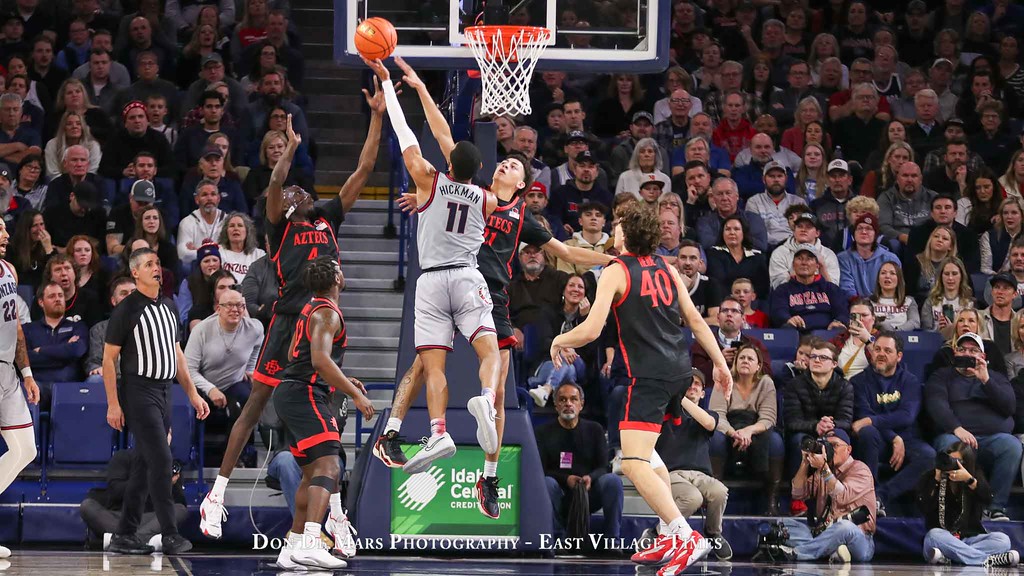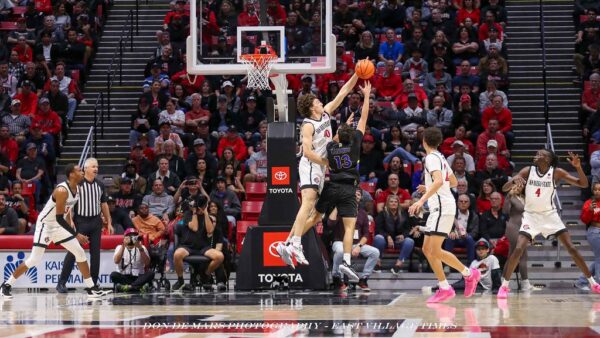Aztec Defense: breaking basketball conventions

Miles Byrd contests a shot against Gonzaga. (Don De Mars/EVT)

The Aztecs are well known as a team with a defensive identity. In six of the seven years Brian Dutcher has been the head coach of the program, the Aztecs had a top-30 defensive efficiency, according to KenPom. In three seasons, they had top-10 defenses. It is a well-known fact that if a player wants to play at San Diego State, they need to play defense.
What is interesting is that San Diego State has a number of unique tendencies that seem to break basketball norms. In terms of aspects of the game that fundamentalists claim are keys to success, the Aztecs often go against the grain.
In an exclusive interview with the East Village Times, coach Dave Velasquez spoke about some of what makes the Aztecs’ defense special, and it starts at the top. In football, there is a defensive coordinator. Someone who is solely in charge and responsible for what the defense is taught, what they do on the field, and when they do it. Basketball teams often have similar roles, even though the title won’t be the same. San Diego State takes a different approach.
“Obviously, someone is going to lead a certain side of the ball, but we’re all coaches,” said Velasquez. “We all have really good input. We all add value in our own way. I think it’s important for everybody to feel like they have freedom to help on both sides of the ball.”
Any coach can help out any player with any concept at any time. From a teaching standpoint, it’s easy to see how that might be beneficial. If one person is solely responsible for the team’s defense, there is a lot they might miss when trying to watch and teach fifteen or more players what to do.
It can also help build a culture of accountability rather than blame. If everyone is responsible for the team’s performance, then when something goes wrong, everyone can skip the part where blame is thrown because it is on everyone. They can get straight to fixing it instead.
That is not the only aspect that is unique to the Aztecs, nor is it the most controversial. Defenses are often built from the inside out. The first priority is usually figuring out how to protect the rim. This is because layups are the easiest and most efficient shots, so offenses prioritize them.
Take the two national championship participants last season. UCONN and Purdue both had elite rim protectors in Donovan Clingan and Zach Edey, respectively. The behemoths made it difficult for opponents to score at the rim, and perimeter defenders were often asked to funnel drives into the big man waiting in the paint. While Velasquez said Magoon Gwath’s size, athleticism, and instincts should give SDSU the shot blocker they lacked last year, building the Aztecs’ defense does not begin there.
“I think for us, it starts with guarding the ball,” Velasquez explained. “… You don’t really build in-out or out-in. You kind of have to be able to do all things.”
The Aztecs have a system that is designed to prevent opponents from driving into the paint, rather than contesting the shot when they get there. They do so by playing a pack-line style defense that will often switch defenders on ball screens. Those two factors lead to opponents seeing multiple defenders in between them and the hoop on every drive.

“It’s more team defense more than anything,” said Velasquez.“When you play San Diego State it’s never one on one, you’re playing one on five. We put a lot of attention to the ball.“
That attention puts a lot of pressure on opposing ball handlers and can often lead to mistakes.
No defensive scheme is perfect, though. Teams have to decide what they want to take away and what they are comfortable giving up.
SDSU’s attention to the ball and preventing penetration into the paint has led to opponents shooting a lot of threes. Only 22 teams in the country gave up more shots from behind the arc than the Aztecs last season.
In SDSU’s pack-line system, defenders often provide help despite only being “one pass away.” When the off-defender leaves his man to help against dribble penetration, it is difficult to rotate and leaves athletes space to shoot from deep.
Helping one pass away is a big taboo among basketball coaches because it seemingly always leads to an open shot, especially from behind the arc. From an efficiency standpoint, open three-point shots are the second-best shot a player can take (after layups/dunks), so preventing them is a priority. Yet, despite breaking this taboo, the Aztecs have had a top-30 overall defense in six of the seven years Coach Dutcher has been in charge. It works because they force a lot of misses. Last season, SDSU’s opponents shot just 31.6% from three, which ranked no. 29 in the nation according to KenPom.

What is even more surprising is the consistent success the Aztecs have had. There have been multiple mathematical studies that have shown defense affects whether or not a three-point shot is taken, but not whether it is made. This has led more analytics driven coaches to sell-out on preventing three-point shots, often at the cost of giving up layups. But as previously noted, the Aztecs allow, and often encourage, three-point attempts.
The accepted belief among the analytics crowd is that three-point percentage allowed basically comes down to luck because defenses do not affect whether or not a shot goes in. A team might be elite at forcing misses one year and terrible the next.
The Aztecs are challenging that notion, having been in the top 30 nationally in three-point percentage allowed for three years running. Coach Velasquez acknowledged that what SDSU does flies in the face of convention but attributed the success to the team’s mentality.
“There’s definitely some things we teach that are a little different in terms of how we guard the three,” Velasquez said. “I don’t think you’re ever going to watch us play and not have a contested shot. There’s a lot of times that the next guy is going to rotate over and still contest that shot even if it might not have been his man. It’s what we call ‘help the helper.’ The length and athleticism definitely plays a part, but I think it’s more a consistency in how we do what we’re doing.”
In multiple ways, the Aztecs do things defensively that go against the grain. They build their defense by focusing on the ball rather than the rim, helping one pass away, and allowing opponents to take three-point shots. Those are all choices that are supposed to hurt defenses in the long run. If that is the case, how have the Aztecs been so successful?
Coach Velasquez attributes the success to two things. The first is effort.
“Hopefully, when you watch San Diego State basketball, we’re going to play as hard as anybody, and we’re always going to be in a stance, he said.”
The program prides itself on aiming to compete harder than its opponents. Elite effort allows it to compensate for the weaknesses of its non-traditional approach and for the inevitable mistakes players make during a game. Heart is a quality analytics cannot measure.
The other aspect coach Velasquez pointed out was the defensive fundamentals the coaches instill from day one.
“It’s really more habits than anything else,” he said. “High hands on every close-out is a real sticking point for us. It’s getting into a run when you get beat. The main thing that we do as good as anybody is what we call fix it, and that means that if somebody gets beat, someone is going to help you, then you got to help them for helping you.”
More than any type of unique or intricate scheme the Aztecs have in place, the key seems to be the little things. And that makes sense. Knowing where to stand isn’t very helpful if the player’s hand isn’t up to contest the shot. Knowing the proper rotation doesn’t matter if the rotation starts when an opponent catches the ball rather than when the pass is thrown. By the time the catch is made, it’s too late.
“I think those habits are formed every single day, and I think a lot of those times those habits are the ones that help you the most,” Velasquez continued. “… As simple as it sounds, it’s probably one of the hardest things to do on the basketball court, especially considering the number one enemy of any player is frustration.”

That last line is important, because it is arguably the outcome that leads to all of SDSU’s success.
The flow chart would go like this: Habits lead to fighting through frustration. Fighting through frustration leads to good execution. Good execution leads to frustrating their opponents. The opponents’ frustration leads to bad execution. Good execution by the Aztecs and poor execution by the opponent leads to a win.
Overall, the Aztecs have had a successful defense despite using some unique practices. It works for them because of the effort and habits they build over the course of the season. The game and the schemes can change, but this foundation carries over year after year, generation after generation. As long as the Aztecs keep that mindset, they should be successful heading into the future.
Native San Diegan living in Montana. Big time Aztec Basketball fan. Creator of Aztec Breakdown. Hoping to help people enjoy basketball more by increasing their understanding of it.